Cascade is among Magic’s sweetest mechanics. It takes ones of the best things in card games—drawing an extra card—and spices it up by guaranteeing a spell and casting it for you. Its a perfect Tammy mechanic by virtue of it being both random and all-upside. It’s also one of Magic’s hardest mechanics to balance, since increasing the mana cost (which makes cards weaker) makes Cascade stronger by virtue of enabling you cast expensive free spells.
Cheap Cascade cards are perhaps the most powerful of all, since you can construct a deck to control exactly what you hit—like Ancestral Vision or Living End. This is why every Cascade card costs 3+ mana and why Cascade hasn’t shown up in Standard since its introduction in Alara Reborn.
Commander Legends can get away with including powerful mechanics like Cascade by virtue of multiplayer being self-balancing. And thanks to this, we get to see Cascade pushed in a whole bunch of new directions. Today, we’ll check out all the new Cascade design space Commander Legends has mined.

Maelstrom Wanderer already innovated that a card could Cascade multiple times. Apex Devastator politely acknowledges that this is indeed cool, ruminates on green’s ability to GO HUGE, and then does exactly that. The beauty of this design is the elegance of just having four identical keywords (that have rather inelegant reminder text) on a vanilla creature—yet being an unforgettable card every time it is cast.

Volcanic Torrent and Sweet-Gum Recluse are excellent examples of designing to an affordance of Cascade (affordance being game design lingo for “something the game component enables to happen”). A single card with Cascade casts two spells, so it enables Storm-like designs that work with themselves. Volcanic Torrent is a one sided Pyroclasm (that hits planeswalkers) that you can scale up even higher with cheap spells (you can even go full-storm and lead with a couple rituals for maximum effect). Sweet-Gum Recluse is more restrictive, since you really want it to Cascade into a creature, but it has the side benefit of letting you play spider-politics.
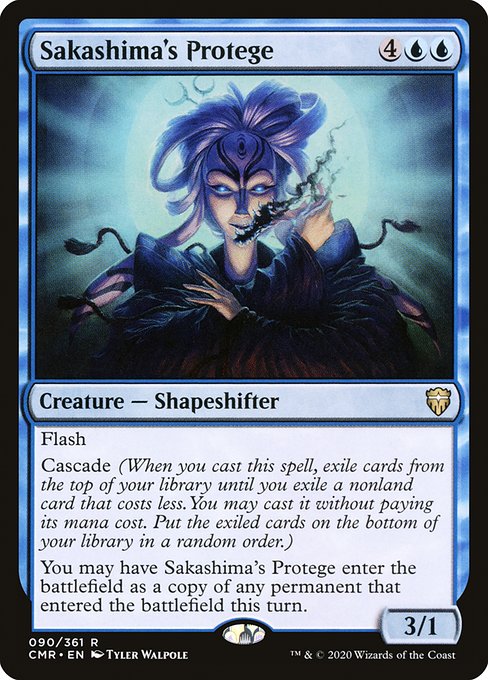
Sakashima’s Protege is in the middle, being less flexible than Volcanic Torrent but more so than Sweet-Gum Recluse. There’s plenty more that could be done in this vein—name a Storm card and you could make a Cascade version of it. This would normally be a huge problem since it combines two of Magic’s strongest mechanics, but a lot more designs are possible when they have to compete in the arenas of Commander and Legacy but not Standard.
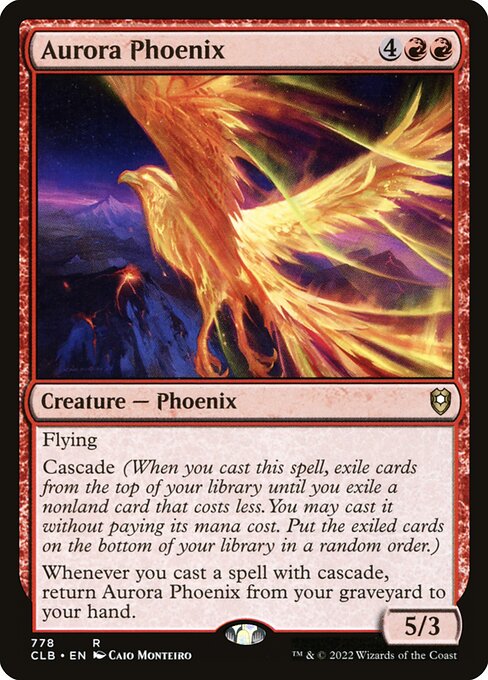
Magic regularly has phoenixes that use set themes to recur themselves (Arclight Phoenix, Phoenix of Ash, and Everquill Phoenix being some of the latest examples). The strongest ones tend to play themselves back to the battlefield; here that would be a weakness, rather than a strength. The goal of Aurora Phoenix is the same as that of Etherium-Horn Sorceror, Enigma Sphinx, and Maelstrom Wanderer as a commander: keep Cascading for value.
Given that Zendikar Rising just introduced copies of creature spells becoming creature tokens and that Volcanic Torrent is playing in the space of Storm, perhaps in a future Commander release we’ll get a Storm Phoenix that recurs and duplicates itself when you Storm off?
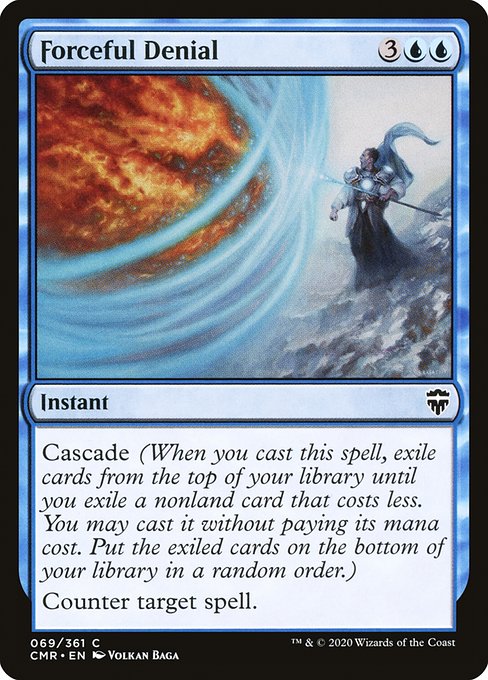
Cascade spells want to be proactive and go into decks with other proactive cards. There’s a reason that Bloodbraid Elf cascades into Thoughtseize but not Remand—proactive cards are more likely to be useful when Cascaded into, while reactive cards might have no use when they’re randomly available. The majority of Cascade cards are themselves proactive to ensure you can them once you’ve got sufficient mana and get the value off of Cascade. Well, Forceful Denial says phooey to that. In a format with all of Magic’s best countermagic available, Forceful Denial duplicates Force of Will‘s mana cost and eschews using a spell to cast it for free to instead casts a free spell for you.
Counterspells are contentious. Some people love having control over the flow of the game while others hate to be so controlled. The brilliance of Forceful Denial lies in adding whimsy and unpredictability to the experience. It punishes you for cascading into another counterspell, so it encourages filling your deck with different sorts of cards to Cascade into and forces you to improvise with what you get. That’ll make more for both a more memorable counterspelling experience as well as forcing players not to fill their decks with countermagic.
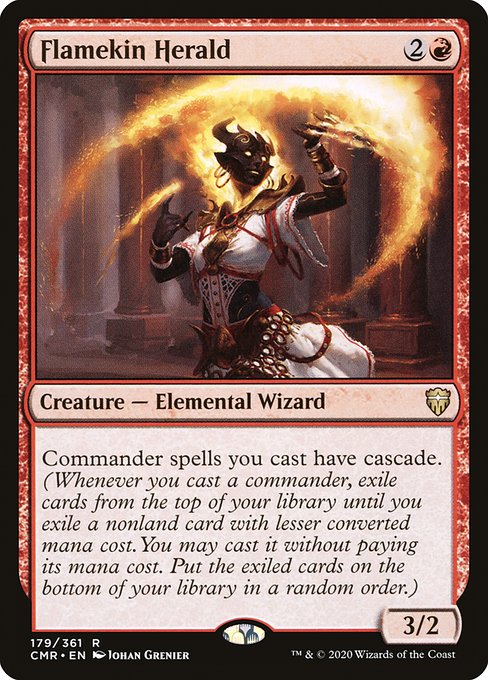
Flamekin Herald is an excellent mix of Jenny and Tammy principles. You can use her to make casting your Commander even more exciting and valuable, or to guarantee that your Kediss, Emberclaw Familiar casts a Wheel of Fate or Restore Balance before landing. As a former Living End player, I love the idea of being able to turn my Commander into a guaranteed spell. As a game designer, I appreciate anything that takes a regular game action like casting my Commander and makes it even more exciting.
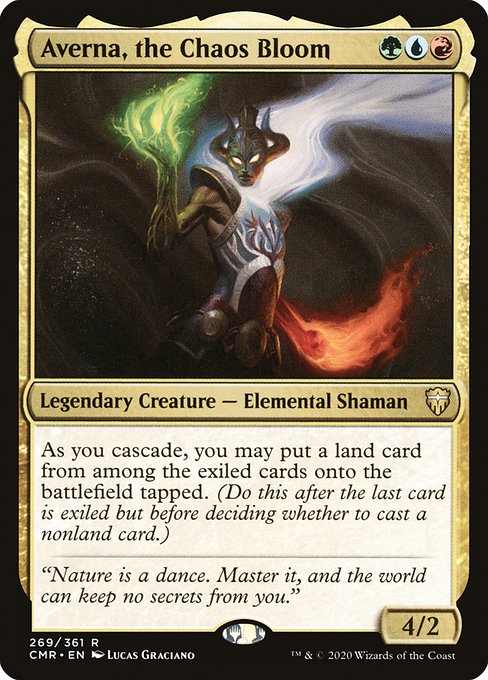
While we’re on the subject of making something more exciting, let’s conclude with Averna, the Chaos Bloom, who makes Cascading even better. Cascade spells tend to err on the expensive side, so having a Commander that adds ramp to your Cascade spells to help them Cascade into more Cascaders is absolutely perfect. Averna even gets you to care about something you’d normally ignore—lands are to be skipped while Cascading, but Averna instead has you focus on everything you’re flipping over, creating meaning where once there was rote ignoring. This is the kind of card that makes me excited to watch and play Commander and I look forward to more such cards in the future.
While I sadly won’t be drafting Commander Legends any time soon, I look forward to seeing content of folks who build Sealed decks, draft it on Magic Online, and how the format shakes out with all these new goodies. Here’s hoping we’ll have ample opportunity to play Commander Legends, in person as it was intended, in the not-too-distant future.
And, as always, thanks for reading.
—Zachary Barash is a New York City-based game designer and the commissioner of Team Draft League. He designs for Kingdom Death: Monster, has a Game Design MFA from the NYU Game Center, and does freelance game design. When the stars align, he streams Magic (but the stars align way less often than he’d like).

